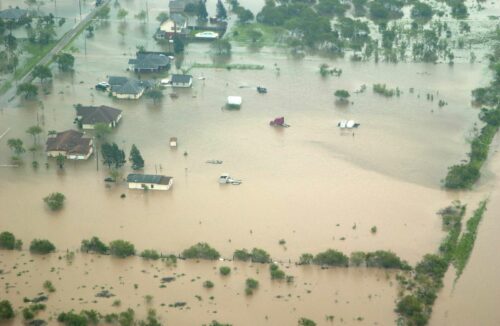Image courtesy of the U.S. Coast Guard.
Not all rivers run on land. Atmospheric rivers (ARs) are pathways of intense water vapor transport in the extratropics, the mid-latitude areas beyond the tropics. Seung Hun Baek and Juan Lora at Yale’s Department of Earth and Planetary Sciences examined new models to evaluate the past and future influences of human activity on AR fluctuations.
An AR can be advantageous or detrimental depending on its strength. The Scripps Institution of Oceanography at the University of California San Diego categorizes ARs based on a five-level scale, ranging from “weak” to “exceptional” in strength and “beneficial” to “hazardous” in impact. An AR of level two (Moderate) can help replenish low reservoirs after a drought, but ARs of four and five (Extreme and Exceptional) often lead to heavy precipitation and floods.
Higher temperatures can strengthen ARs by increasing the amount of water vapor in the air. Two important factors that affect temperature are the warming effects of greenhouse gases (GHGs) and the cooling effects of industrial aerosols, such as smoke and particulate air pollutants. Baek and Lora showed that there was little human-induced change in AR characteristics from 1920-2005, as the effects of GHGs canceled out those of aerosols. Compared to natural variability, human activity only caused statistically significant changes in the North Atlantic and the Southern Pacific, and these changes were small in scale.
However, when the scientists applied the same framework to project future changes, they saw a drastically different picture. Relative to the historical evaluation, they predicted far more vigorous ARs from 2005-2080, simulating a roughly twenty-millimeter per month rainfall increase in many regions and over one hundred percent more frequent extreme precipitation over much of Europe. These natural disasters can lead to flooding, property losses, and casualties.
Baek and Lora used the Representative Concentration Pathway of 8.5 watts per square meter (RCP8.5) in their prediction model. The RCPs were proposed by the United Nations Intergovernmental Panel on Climate Change (IPCC) in its Fifth Assessment Report. They represent a series of GHG concentration scenarios, and RCP8.5 corresponds to “very high GHG emissions.” In 2014, the IPCC stated that without additional efforts to constrain emissions, the baseline condition would fall between RCP6.0 and 8.5. “[RCP8.5] is certainly pessimistic, but it is possible and very worth thinking about, as we’ve been following that trajectory relatively closely,” Lora said. Plus, the models stay conceptually valid regardless of the numbers. “If greenhouse gases went up less, the intensification of atmospheric rivers would be less. But qualitatively it will still go up,” Baek said.
The researchers also evaluated the altitude of changes in AR characteristics. Changes at a higher altitude, although smaller in magnitude, closely mirror those at a lower altitude. “Mid-latitude weather systems have a vertical structure that goes from the surface up into the troposphere, so we want to understand how these [AR] changes occur in the vertical direction as well,” Lora said.
With such large experiments came numerous challenges. Collecting and analyzing the data was an especially arduous task. “Atmospheric rivers use daily data, so it’s pretty high resolution temporally. I think we analyzed or generated something like twenty terabytes of data.” Baek said.
Lora, on the other hand, expressed words of gratitude. “Yale maintains very good computing capabilities. [During the pandemic,] we are lucky as computational scientists in that we run simulations and analyses on computers that we can access remotely,” he said.
It is astonishing that industrial aerosols, an important air pollutant, can cool the atmosphere. Can humans make use of this property? Indeed, solar geoengineers have been considering injecting aerosols into the stratosphere. This field has received much attention recently, but its implementation is currently far from reality due to many unknown consequences. “Think about the mass extinction event that killed the dinosaurs. A large proportion of that was probably due to aerosols blocking the Sun. So maybe it’s not [a path] we want to go down,” Lora said.
In future studies, the scientists hope to examine the influence of global patterns, such as the El Niño–Southern Oscillation, on atmospheric rivers. Several regional studies have observed these phenomena, but simulations like the one in this paper can help paint a global picture. The scientists also aim to elucidate the impact of individual forcings, or perturbations to the Earth system, on atmospheric rivers—not only to gain an insight on this elaborate system, but also to shed light on the possible effects of solar geoengineering and other human modifications to the atmosphere.

